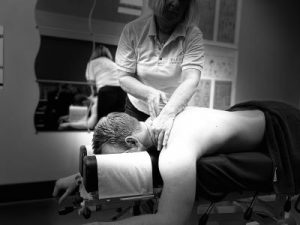Massage
 During periods of stress on the body muscles can create trigger points and tension. Having a regular massage can optimise tissue pliability, which may reduce injuries and improve mobility.
During periods of stress on the body muscles can create trigger points and tension. Having a regular massage can optimise tissue pliability, which may reduce injuries and improve mobility.
The effect of massage is that by increasing oxygen to the blood it helps filter out the different type of toxins that build up in the body such as lactic acid, uric acid and other metabolic waste.
Massage can help improve negative sedentary effects that for example working at a desk, sitting in a car has on posture. This can cause muscles to shorten and pull joints into positions which over time can reduce function increasing the chances of over-use or repetitive strain injuries. By releasing these muscles massage helps to counteract this.
Sports Massage
Sports massage targets structures of deep muscle and fascia or connective tissue. It is often used on smaller muscle injuries or ongoing chronic conditions, sports injuries, spasms, whiplash, postural alignments and muscle tension.
 This type of massage may involve the stretching of facia, releasing tension in muscles and connective tissue to facilitate changes in posture and flexibility. The therapist may use fingers, thumbs, fists, elbows and forearms as part of this treatment and in addition will focus on muscle spasms and on knots and adhesions in the muscles.
This type of massage may involve the stretching of facia, releasing tension in muscles and connective tissue to facilitate changes in posture and flexibility. The therapist may use fingers, thumbs, fists, elbows and forearms as part of this treatment and in addition will focus on muscle spasms and on knots and adhesions in the muscles.
Sports massage can aide recovery from delayed onset muscle soreness (DOMS) by increasing circulation to the area massaged, it helps to flush out toxins that build up during exercise.
Sports massage is suitable for everyone not just athletes. Typically it is beneficial for anyone experiencing chronic muscular pains helping to improve both posture and range of motion (ROM) during the healing process.
Swedish Massage
Swedish Massage is the most commonly available massage technique using both firm or lighter pressure on the muscles. These techniques aids or improve circulation of blood and lymph, increasing blood flow and reducing tension in the muscles whilst improving flexibility. Its focus is to improve moods and enhance relaxation and sleep.
Not only does it stimulate the skin it also enables the body to relax and reduces emotional and physical stress in the body. More gentle strokes are used on the more boney or delicate areas of the body and firmer strokes where the muscle cover is deeper.
Indian Head Massage
Indian Head Massage is a holistic therapy that uses acupressure massage to relax the head, face, neck and shoulders which are the areas most affected by stress.. It is effective in reducing stiff muscles in those areas thus reducing pain, alleviating tension and improving mobility.
By alleviating stress Indian Head Massage supports the nervous system and stimulates the lymphatic system. Thus it assists in the elimination of toxins, can relieve chronic pain or stiffness in the neck and shoulders. In addition it increases the oxygen circulating in the tissues and thus improves circulation.
Reflexology
Reflexology is classed as an alternative or complementary therapy that involves applying pressure to the feet or hands with the use of specific finger, thumb or hand techniques and may involve the use of lotion. It is non-invasive and can be effective in promoting relaxation and a feeling of wellbeing and aid the body’s own healing system.
As a ‘touch’ therapy there is a theory is that different points on the feet or hands correspond with different zones or areas in the body and by focussing on these to stimulate energy pathways (similar to acupuncture). If the therapist feels tender, crunchy or sensitive areas theory suggests that this may correspond with an area on the body and by massaging or pressing these points this may be beneficial.
